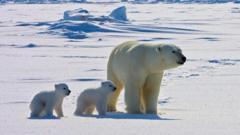A recent study indicates that climate change is correlating with higher incidences of pathogens in polar bears, revealing significant implications for their survival in a rapidly changing ecosystem.
**Rising Arctic Temperatures Elevate Disease Risk for Polar Bears**

**Rising Arctic Temperatures Elevate Disease Risk for Polar Bears**
As the Arctic continues to warm, polar bears are increasingly at risk of exposure to diseases that threaten their population health.
In the face of climate change, polar bears are developing a higher susceptibility to diseases previously less common among them. This alarming trend emerges from a comprehensive study conducted on polar bear blood samples from the Chukchi Sea region, straddling the borders of Alaska and Russia. By comparing samples collected from 1987 to 1994 with those gathered between 2008 and 2017, researchers discovered a notable increase in the presence of pathogens, including viruses, bacteria, and parasites.
The study, led by wildlife biologist Dr. Karyn Rode at the U.S. Geological Survey, underscores the broader ecological changes taking place as sea ice diminishes. Dr. Rode noted that with the loss of ice, polar bears are spending more time on land, exposing them to land-based pathogens that were historically uncommon in their habitat.
The six pathogens tested included two parasites linked to toxoplasmosis and neosporosis, as well as bacteria responsible for rabbit fever and brucellosis, along with the virus that leads to canine distemper. The research highlights a shift in the Arctic ecosystem impacting polar bears, suggesting that as their hunting conditions worsen with diminishing ice cover, the bears' health could be adversely affected by increasing pathogen exposure.
Although polar bears are generally resilient against disease, Dr. Rode emphasizes that the current changes illustrate significant shifts in their environment. With around 26,000 polar bears remaining globally, many are facing an uncertain future as they struggle to find sufficient food on land and encounter new health threats.
The alarming findings have led to heightened concern among scientists, as the polar bear's classification as a vulnerable species by the International Union for Conservation of Nature becomes increasingly pertinent. Their primary threat remains the continuous loss of sea ice, which serves as a crucial hunting platform for these apex predators.
As polar bears venture further onto land due to ice scarcity, they face an increased risk of encountering these pathogens, signaling a troubling chain reaction within the Arctic's ecological balance. These findings, published in the journal PLOS One, raise critical questions about the future of not just polar bears, but the entire Arctic ecosystem as global temperatures rise.
The study, led by wildlife biologist Dr. Karyn Rode at the U.S. Geological Survey, underscores the broader ecological changes taking place as sea ice diminishes. Dr. Rode noted that with the loss of ice, polar bears are spending more time on land, exposing them to land-based pathogens that were historically uncommon in their habitat.
The six pathogens tested included two parasites linked to toxoplasmosis and neosporosis, as well as bacteria responsible for rabbit fever and brucellosis, along with the virus that leads to canine distemper. The research highlights a shift in the Arctic ecosystem impacting polar bears, suggesting that as their hunting conditions worsen with diminishing ice cover, the bears' health could be adversely affected by increasing pathogen exposure.
Although polar bears are generally resilient against disease, Dr. Rode emphasizes that the current changes illustrate significant shifts in their environment. With around 26,000 polar bears remaining globally, many are facing an uncertain future as they struggle to find sufficient food on land and encounter new health threats.
The alarming findings have led to heightened concern among scientists, as the polar bear's classification as a vulnerable species by the International Union for Conservation of Nature becomes increasingly pertinent. Their primary threat remains the continuous loss of sea ice, which serves as a crucial hunting platform for these apex predators.
As polar bears venture further onto land due to ice scarcity, they face an increased risk of encountering these pathogens, signaling a troubling chain reaction within the Arctic's ecological balance. These findings, published in the journal PLOS One, raise critical questions about the future of not just polar bears, but the entire Arctic ecosystem as global temperatures rise.





















